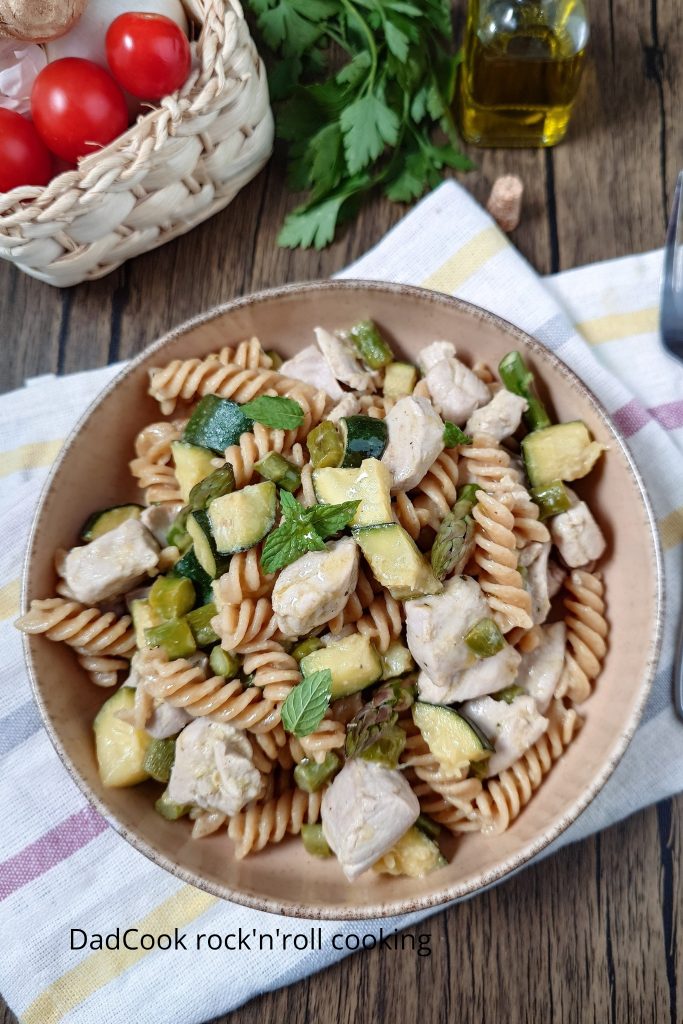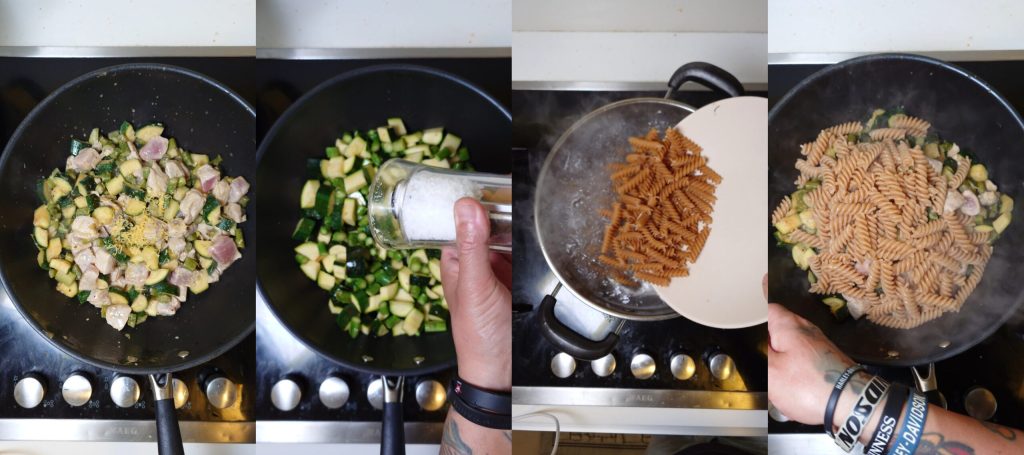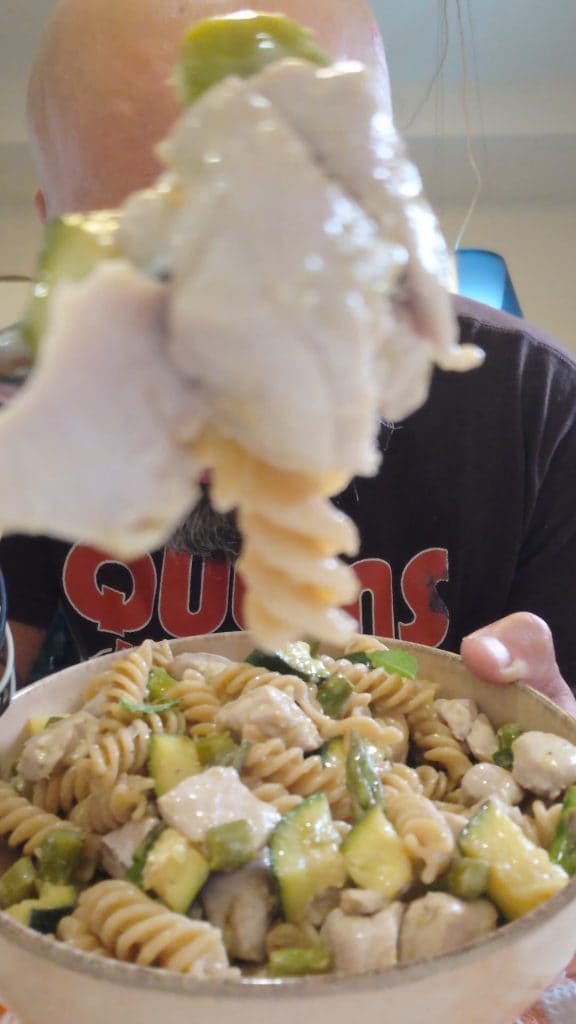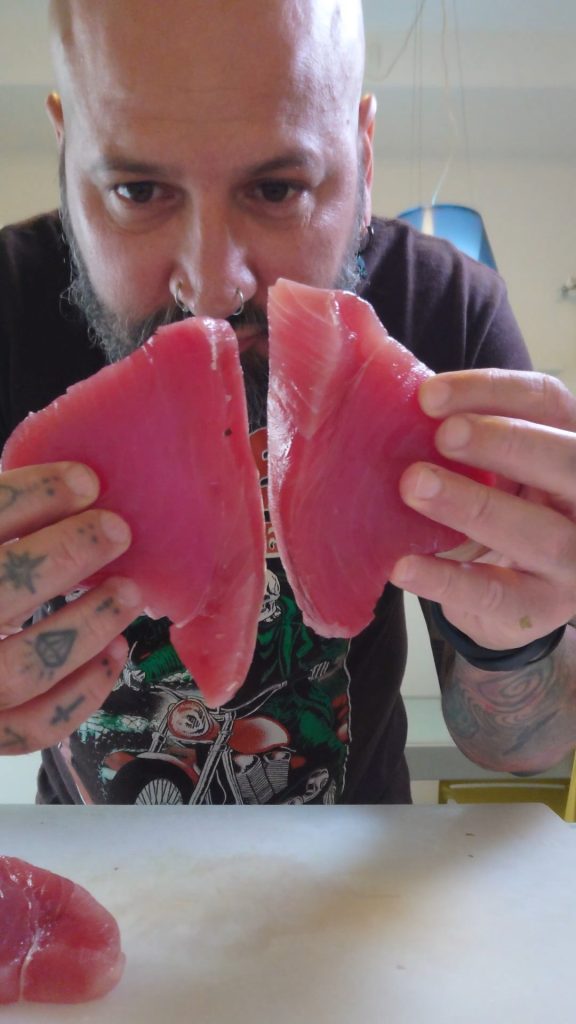How many times have you stared at the fridge at seven in the evening, with the same question echoing in your head:
“What do I prepare that’s good, quick, and not the usual sadness?”.
I know, the temptation to resort to the classic quick spaghetti is strong, but today I have the solution for you, the breakthrough you were waiting for.
Forget everything you know about pasta with zucchini and tuna, because this isn’t your childhood recipe.
Today I reveal how to transform a humble dish into a true summer gourmet recipe, ready in less than 25 minutes.
The secret?
It’s simple but genius: use a fresh tuna cut and just sear it, forget the can!
The result is a flavorful, light dish that’s so good it seems like it’s straight out of a seaside restaurant.
It’s the perfect recipe for summer evenings, when you want something special without spending hours at the stove, a bit like when we prepared my super fast shrimp and avocado salad together last week.
The beauty of this dish is its freshness.
The zucchini remain crunchy and the tuna, very tender, perfectly matches the whole wheat pasta.
It’s a complete and balanced meal that follows the philosophy of healthy and tasty cooking that we love so much.
If you, like me, are trying to bring light dishes to the table without sacrificing flavor, you will surely remember the success of our baked salmon with crispy asparagus, another winning idea for eating well.
This pasta with tuna cut and zucchini has become my workhorse, I make it very often when I want to impress without stress.
It’s versatile, and if you have unexpected guests, you can serve it as a main course, perhaps after an appetizer like my crunchy Tuscan panzanella.
Are you ready to discover the secret to a tuna pasta that will make you forget the can forever?
Let’s get started.
- Potato, Green Bean, and Tuna Salad: The Perfect Recipe and 5 Mistakes to Avoid
- Creamy Pasta with Zucchini and Peas: The Light and Quick Summer Recipe
- Roasted Peppers: They Are All the Rage! Perfect Peeling Trick
- Chicken Cif Ciaf: Easy and Tasty Original Abruzzo Recipe
- Sardine Pasta to Die for, Simple and Quick That Wins You Over

- Difficulty: Very Easy
- Cost: Medium
- Preparation time: 10 Minutes
- Cooking methods: Stovetop
- Cuisine: Italian
- Seasonality: Spring, Summer, All Seasons
- Energy 407.32 (Kcal)
- Carbohydrates 48.19 (g) of which sugars 4.10 (g)
- Proteins 31.89 (g)
- Fat 10.46 (g) of which saturated 3.44 (g)of which unsaturated 4.67 (g)
- Fibers 6.61 (g)
- Sodium 202.76 (mg)
Indicative values for a portion of 390 g processed in an automated way starting from the nutritional information available on the CREA* and FoodData Central** databases. It is not food and / or nutritional advice.
* CREATES Food and Nutrition Research Center: https://www.crea.gov.it/alimenti-e-nutrizione https://www.alimentinutrizione.it ** U.S. Department of Agriculture, Agricultural Research Service. FoodData Central, 2019. https://fdc.nal.usda.gov
Ingredients
- 12 oz whole wheat fusilli
- 1.1 lbs tuna (Fresh, frozen)
- 4 white zucchini
- 1 bunch asparagus
- 1 bunch parsley
- 2 cloves garlic
- 1 lemon (Untreated)
- to taste extra virgin olive oil
- to taste salt
- 1 g black pepper
Tools
- 1 Saucepan Moneta
- 1
Steps
Prepare the Vegetables: Cutting and Textures
The first step to an exceptional dish is to treat the ingredients well.Take the asparagus: you don’t need a knife to find the right part.
Hold the stalk with two hands and bend it: it will snap at the exact point where the woody part gives way to the tender part.
Set aside the tips, which we’ll use at the end for a masterful touch.
Slice the tender part of the stalk thinly.
Move on to the zucchini: trim them and cut them first into slices and then into cubes not too small, so they remain firm and crunchy during cooking.
The Star: Why Fresh Frozen Tuna Makes the Difference
The secret of this recipe is all here: fresh tuna.Buy it already frozen, a rapid cooling process that eliminates any risk and makes it safe to be consumed almost raw.
This allows us to sear it for just a few moments, obtaining a tasty outer crust and a pink, very tender heart that melts in your mouth.
Cut it into cubes about 0.8 inches and set it aside, ready for the grand finale.

In the Pan: Creating the Flavor Base
In a large pan, heat a generous splash of extra virgin olive oil and gently fry the two garlic cloves.
When they are golden, remove them and pour in the asparagus slices.
Sauté them over high heat for a couple of minutes, then add the zucchini.
The keyword is “crunchiness”: cook the vegetables for about 5-7 minutes, they should remain bright and firm.
Deglaze with a splash of white wine and let the alcohol completely evaporate, releasing a fantastic aroma.
At this point, with the vegetables still perfect, add the tuna cubes and sauté them over very high heat for a minute, no more.
They should just change color on the outside.

The Magic Moment: Combining and Creaming
Turn off the heat under the pan with the sauce.
This is a crucial step not to overcook the tuna and keep it very tender.
With the heat off, add the aromatic grated lemon zest and adjust salt and pepper.
Meanwhile, your pasta will have cooked.
Drain it al dente, but don’t throw away all the water: keep a glass, it’s our “liquid gold” rich in starch that will help us bind everything.
Pour the pasta directly into the pan with the sauce.
Turn the heat back on to minimum and add the fresh chopped parsley and – here’s the master touch – the raw asparagus tips you had set aside.
Now mix vigorously for about a minute, pouring a little cooking water at a time, until creating a delicious and light cream that will perfectly coat the pasta.

Plating, Serving, and Final Touch
This pasta should be served without waiting a moment, to enjoy all the different textures at their best.
Generously distribute on plates, ensuring that each diner receives their fair share of tuna cubes, zucchini, and asparagus.
Finish each portion with a drizzle of excellent raw extra virgin olive oil and, if you like, a final grind of black pepper.
Bring to the table and enjoy the contrast between the warmth of the pasta, the softness of the tuna, and the unexpected, vibrant crunchiness of the asparagus tips.

Tips, Tricks and Variations
Storage:
Let’s be honest: this is a dish that gives its best when freshly made.
The magic lies in the difference in textures between the hot pasta, the very tender tuna, and the crunchy vegetables.
My advice is to consume it immediately.
If there are leftovers, store them in an airtight container in the refrigerator for no more than one day.
I don’t recommend reheating it (the tuna would become hard and the pasta would lose its texture), but rather enjoying it at room temperature or cold, like a gourmet pasta salad.
Useful Tips:
Heat is Your Friend: For the vegetables and the tuna, the rule is one: very hot pan and short times. Only this way will you get perfect cooking that seals the flavors on the outside while keeping the inside juicy and crunchy.
Don’t Throw Away the Pasta Water: I repeat it because it’s the real secret for a tied and creamy dish without adding fats.
The starch released by the pasta during cooking is a perfect natural emulsifier.
Always keep a glass aside during the creaming.
The Zest, Not the White: When grating the lemon, be careful to only take the yellow part (the flavedo), which is rich in aromatic essential oils.
The underlying white part (the albedo) is bitter and would ruin the balance of the dish.
Wine Pairing:
This dish calls for a fresh, savory white wine with good acidity, capable of cutting through the palate and accompanying the vegetal notes of the asparagus and the fattiness of the tuna.
Vermentino from Sardinia or Liguria: The almost perfect choice. Salty, citrusy, with the right structure not to disappear in front of the tuna.
Sauvignon Blanc from Alto Adige: A classic with asparagus.
Its herbal notes and sharp acidity pair magnificently with the dish.
A dry Rosato from Salento: If you prefer an alternative, a rosé based on Negroamaro, served cold, with its notes of red fruits and its freshness, can create a surprising and very pleasant pairing.
Variations and Substitutions:
This recipe is a fantastic base to start from.
Here are some ideas to customize it:
Instead of Tuna: Cubes of seared swordfish are a perfect substitute.
Or, for an even quicker version, shrimp or prawns added together with the tuna.
Other Vegetables: If it’s not asparagus season, try small diced yellow peppers for a sweeter note, or cherry tomatoes cut in half and sautéed with the zucchini.
The Crunchy Touch: For an even more pronounced contrast of textures, complete the dish with a sprinkle of chopped pistachios or toasted almonds before serving.
The Creamy Variation:
Want to go all out?
Add a tablespoon of fresh stracciatella or room-temperature burrata to each plate when serving. The hot/cold contrast and creaminess will be exceptional.

Frequently Asked Questions (FAQ)
Can I use canned tuna instead of fresh cut?
This recipe has been specifically created to enhance the soft texture and delicate flavor of freshly seared tuna.
Using canned tuna would result in a completely different dish, more similar to a classic tuna pasta.
If you only have that available, I suggest adding it at the end off the heat, well-drained from its oil, but the result won’t have the same magic.
Is it safe to eat tuna if it’s almost raw inside?
Absolutely yes, on one fundamental condition: the tuna must have been “frozen”.
Freezing is a rapid freezing process at very low temperatures that eliminates any health risk.
Always explicitly ask for it when buying fresh fish at the fish market or check that it is specified on the label of the packaged product.
How can I make this recipe gluten-free?
It’s very simple. The sauce is naturally gluten-free. You just need to replace the whole wheat fusilli with a good quality gluten-free pasta that holds up well to cooking (for example, corn and rice or buckwheat based). The cooking times of the pasta may vary, so follow the instructions on the package.
Can I prepare something in advance to speed up the preparation?
Of course.
To optimize time, you can cut all the vegetables (asparagus and zucchini) even a few hours before and store them in an airtight container in the refrigerator.
However, I advise against cutting the tuna too early to preserve its freshness.
The ideal is to have the vegetables already ready, and then focus on the actual cooking just before going to the table.

